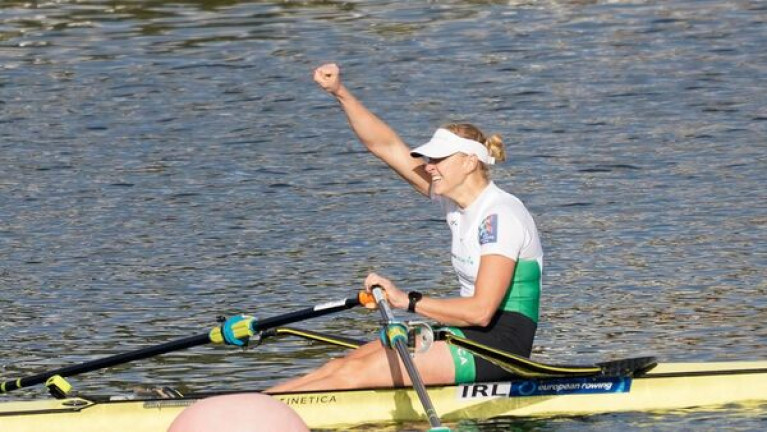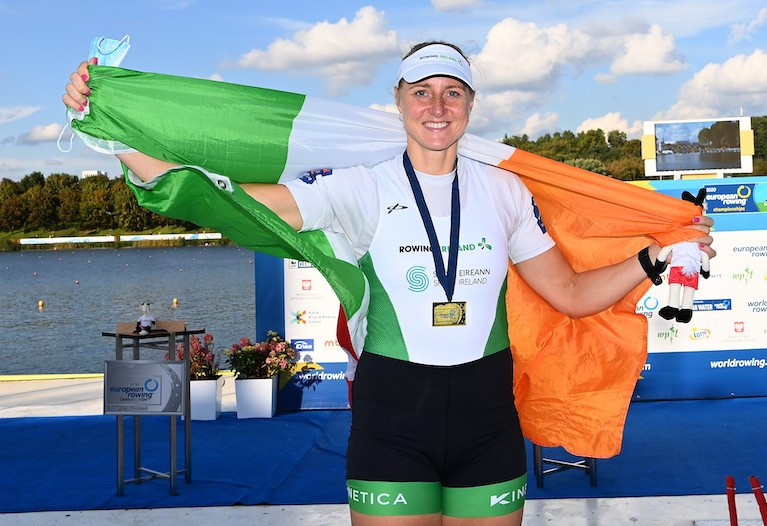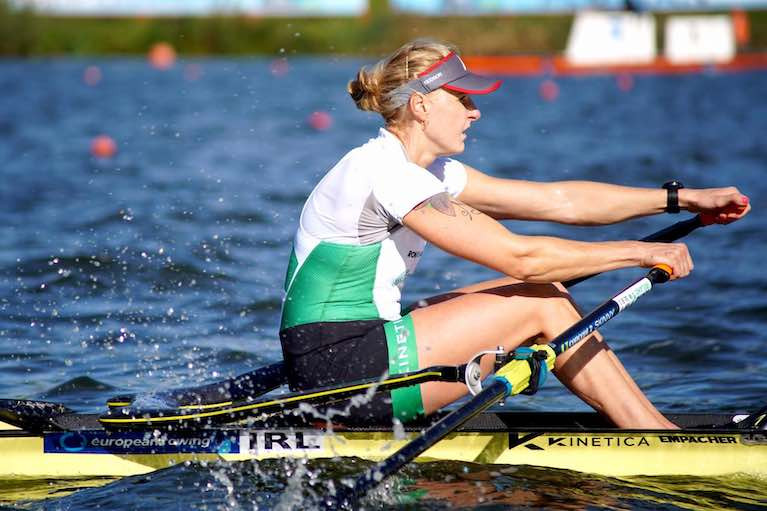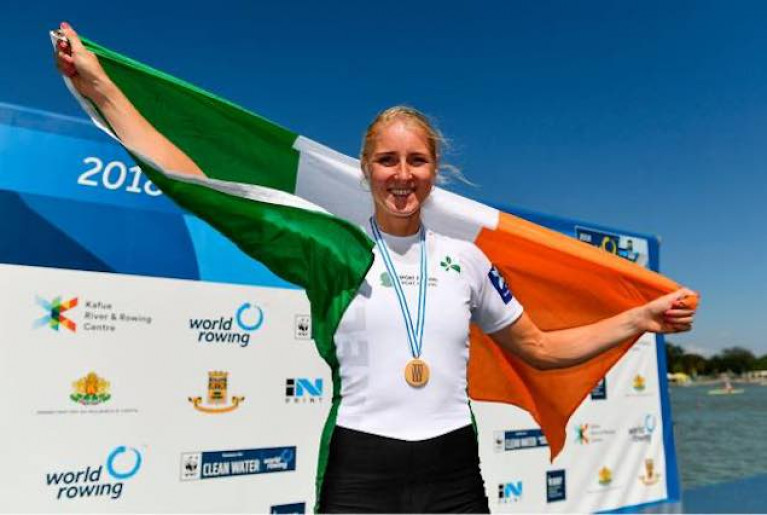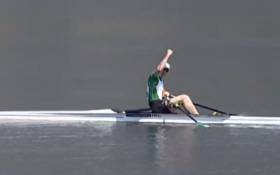Displaying items by tag: Sanita Puspure
Annalise Murphy, Sanita Puspure, Claire Lambe and the rest of the Team Ireland Athletes’ Commission are calling on all Olympians, past and present, and high performance athletes on their sports national team (both junior and senior) to join them for a social event to discuss the importance of 'Enjoying the Journey'.
The event at the Sport Ireland Campus in northwest Dublin on Wednesday 14 December will also serve as an official launch of the Athletes’ Commission Strategy for 2022-2024, with details of the related activities, supports and actions to be announced.
The event will be an interactive event, aimed at creating engaging discussion around the various challenges and opportunities for high performing athletes, and the importance of remaining focused at all times on finding enjoyment and happiness in the steps along the way.
MC David Gillick (Olympian and former Athletes' Commission member) will guide two panel discussions around the topic, touching on key points such as how to celebrate success, and tips and advice from the experienced Olympians in the room.
The event will be brought by the Athletes' Commission who are: Shane O’Connor (chair), Natalya Coyle (vice chair), Olympic sailing hero Annalise Murphy, Olympic rowers Sanita Puspure and Claire Lambe, Brendan Boyce, David Harte and Paddy Barnes, most of who will be present on the day.
Keynote speaker will be Olympic bronze medallist in boxing from Tokyo, Aidan Walsh. In addition, Team Ireland chef de mission for Paris 2024, Gavin Noble — a former Olympian and former Athletes' Commission member — will present on the Paris plans.
Places will be limited so early registration is advisable. Qualifying athletes should email [email protected] for for the registration link.
Olympic Rowers Join Annalise Murphy on OFI Athletes’ Commision
Olympic sailing silver medalist Annalise Murphy is joined by fellow Olympians, rowers Sanita Puspure and Claire Lambe in the latest Olympic Federation of Ireland (OFI) Athletes’ Commission.
The three are among eight athletes elected from a list of 13 for the commission’s 2022-24 term, as the OFI announced today.
All Irish Olympians were eligible to vote in an online platform for seven of the commission’s spots, with Ireland’s sole winter sport candidate Shane O’Connor automatically elected, as previously reported on Afloat.ie.
The regulations made allowance for a minimum gender balance of 40%. However, the election produced a 50/50 gender balance without need to invoke such mechanisms.
Murphy finished 18th overall in the Laser Radial at Tokyo 2020 last summer, and has since called time on her Olympic sailing career.
Also in Tokyo, Puspure reached the B final of the women’s single scull before withdrawing due to illness.
And before her retirement from international competition ins 2018, Lambe was a finalist in the women’s lightweight double sculls at Rio 2016.
The three women and O’Connor will sit alongside race walker Brendan Boyce, boxer Paddy Barnes, hockey international David Harte and modern pentathlete Natalya Coyle in the latest formation of the commission.
OFI president Sarah Keane congratulated the successful candidates and thanked all those who applied.
“We are confident that the athlete voice will be represented well and that you will continue to drive sport forward, each of you bringing with you a wealth of experience,” she said.
“I also want to thank the outgoing Athletes’ Commission who have worked really hard in important areas in sport, from athlete welfare and representation on decision making groups, to driving initiatives that Irish athletes wanted to back, such as anti-doping and tackling racism and discrimination.
“You have given this new commission a very solid point from which they can start.”
The outgoing OFI Athletes’ Commission was appointed in 2017, and consisted of Shane O’Connor (chair), Gavin Noble (vice chair), David Harte (also a member of the EOC Athletes’ Commission), David Gillick (also an athlete representative in Sport Ireland anti-doping initiatives), Kenneth Egan, James Nolan, Melanie Nocher and Judy Reynolds.
Over the coming weeks the new OFI Athletes’ Commission will meet informally, in a virtual setting, and will hold its first official meeting soon after.
The hard decision has been made to withdraw rower Sanita Puspure from the B Final of the Women’s Single, set to occur tomorrow due to her being unwell.
Speaking this evening, Puspure said: “Over the past few days, I have not been well, and I had to make the difficult decision to withdraw from the Olympic Regatta. This is really disappointing, as I had been going well over the past few months and had hoped to continue this good form. The Olympics is always a big goal, so it’s heartbreaking to have to pull out in this manner.”
As regular Afloat readers know, in the final race of the day for the rowers, there was disappointment for Puspure in the semi-finals of the Women’s Single, where she finished fifth in her race, with only the top three progressing to the A Final where the medals are contested.
In her third Olympic Games, the current World Rowing Champion in the Women’s Singles Sanita Puspure won her quarter-final in impressive style in today’s race in Tokyo, and will now compete in the semi-final A/B next Tuesday.
The Women’s Pair of Monika Dukarska and Aileen Crowley and the Lightweight Women’s Double of Margaret Cremen and Aoife Casey also progressed to the semi-finals from their repechages this morning.
There was disappointment for the Men’s Double of Philip Doyle and Ronan Byrne though, whose sixth-place finish in the semi-final in 6.49.06 was not enough to progress to the A Final.
Four Irish boats were racing on the third day of rowing at the Tokyo Olympics. Three Irish boats qualified for the A/B Semi-Finals and the Men’s Double will race in the B Final.
The Women’s Pair of Aileen Crowley & Monika Dukarska finished third in the Repechage this morning. Aileen and Monika competed against Megan Kalmoe & Tracey Eisser (USA), Kaifeng Huang & Jinchao Liu (China) and Maria Kyridou & Christina Ioanna Bourmpou (Greece). Aileen and Monika finished with a time of 07:31.99. Aileen and Monika will race in the A/B Semi-Final Tuesday morning
Margaret Cremen and Aoife Casey finished third in the Lightweight Women’s Double Sculls Repechage. Margaret and Aoife competed against Valentina Cavallar & Louisa Altenhuber (Austria), Thi Thao Luong & Thi Hao Dinh (Vietnam), Patricia Merz & Frederique Rol (Switzerland), Yulisa Lopez & Jennieffer Zuinga (Guatemala) and Anatasia Lebedeva & Maria Botalova (Russian Olympic Committee). Margaret and Aoife finished with a time of 07:23.46. Margaret and Aoife will race in the A/B Semi-Final Tuesday morning.
Sanita Pušpure finished first in the Women’s Single Sculls Quarter-Final. Sanita faced competition from Wing Yan Winnie Hung (Hong Kong), Jovana Arsic (Serbia), Kara Kohler (USA), Yan Jiang (China) and Alejandra Alonso (Paraguay). Sanita won the Heat comfortably with a time of 07:58.30 finishing ahead of Kara Kohler (USA) and Yan Jiang (China). Sanita will now race in the A/B Semi-Final on Wednesday morning.
Ronan Byrne and Philip Doyle finished sixth in the Men’s Double Sculls A/B Semi-Final. Ronan and Phil competed against Miroslaw Zietarski & Mateusz Biskup (Poland), Jack Lopas & Christopher Harris (New Zealand), Graeme Thomas & John Collins (Great Britain), Hugo Boucheron & Matthew Androdias (France), and Stephan Krueger & Marc Weber (Germany). Ronan and Phil finished with a time of 06.49.06 and Ronan and Phil will now race in the B Final on Wednesday morning.
Day 3 Results
Repechage
Women’s Pair (W2-) Monika Dukarska & Aileen Crowley – 4th – 07:31.99
Lightweight Women’s Double Sculls (LW2x) – Margaret Cremen & Aoife Casey – 3rd – 07:23.46
Quarter-Final
Women’s Single Sculls (W1x) – Sanita Puspure – 1st – 07:58.30
A/B Semi-Final
Men’s Double Sculls (M2x) – Ronan Byrne & Philip Doyle – 6th – 06.49.06
Next Irish Races (Confirmed)
Tuesday 27th Racing (IST)
A/B Semi-Final
Women’s Pair (W2-) Monika Dukarska & Aileen Crowley – 02:58/03:08 (TBC)
Lightweight Men;s Double Sculls (LM2x) – Fintan McCarthy & Paul O’Donovan – 03:18/03:28 (TBC)
Lightweight Women’s Double Sculls (LW2x) – Margaret Cremen & Aoife Casey – 03:38/03:48 (TBC)
Wednesday 28th (IST)
B Final
Men’s Double Sculls (M2x) – Ronan Byrne & Philip Doyle – 00:42
Women’s Four (W4-) – Aifric Keogh, Eimear Lambe, Emily Hegarty & Fiona Murtagh – 01:50
A/B Semi-Final
Women’s Single Sculls (W1x) – Sanita Puspure – 02:58/03:08 (TBC)
Rower Sanita Pušpure Receives Cork Honour
Double World and European rowing champion Sanita Pušpure has won the latest Cork Person of the Year award.
Sanita, 39, who was born in Latvia but now lives in Ballincollig, is considered a favourite to take a gold medal in this summer’s Tokyo Olympics.
She is also a past winner of the Irish Times/Sport Ireland’s Sportswoman of the Year award.
Sanita came to Ireland from Latvia in 2006 and became an Irish citizen in 2011.
She has been a member of Irish rowing teams for many years and trains at the National Rowing Centre at Farran Woods in Cork.
Rower Sanita Puspure Honoured at Sportswoman Awards
Rower Sanita Puspure was honoured at The Irish Times / Sport Ireland Sportswoman of the Year Awards after she successfully defended her European title in Poznan, Poland.
Despite having her training regime seriously disrupted and the European Championships being her first competitive event of the year, Puspure was in total control of the single sculls by the halfway stage and cruised to a comfortable victory of over Austrian Magdalena Lobnig and Anneta Kyridou of Greece.
The victory was all the more impressive given last year’s Sportswoman of the Year told RTE she had found training alone a real challenge. “As an athlete it was very hard because we're so used to that competitive environment in training - that's what keeps us going and pushes us every day. The intention to train well was there but I don't think I did because subconsciously there was no motivation to push myself to the very limit of what I could have done.”
Despite those lockdown struggles, the Ballincollig based rower, who is 39, produced the goods yet again to claim her sixth major international medal.
This is the 17th year of the awards and Puspure, who won the overall award last year, was among 11 other monthly award winners nominated for the 2020 title including runner Ciara Mageean, golfer Stephanie Meadow and soccer player Diane Caldwell.
However the overall award this year went to the August winner, Katie Taylor, the undisputed world lightweight champion who was crowned The Irish Times / Sport Ireland Sportswoman of the Year for 2020. It’s the Bray boxer’s fifth time to win the award and comes after she enjoyed a highly successful 2020, defending her titles against Belgian rival Delfine Persoon and Miriam Gutierrez from Spain.
Accepting the award from her US base in Connecticut, she said it was a privilege and a great honour to be recognised in this way. She said that turning professional had been beyond her wildest dreams. “These have definitely been the most enjoyable few years of my whole career and this is coming after my lowest point as well, the Rio Olympics, so it really has been an amazing few year.”
Former soccer international star Olivia O’Toole, the most capped Irish women’s international soccer player of all time, was presented with the Outstanding Contribution to Sport Award 2020. O’Toole, who represented her country 130 times in a career which stretched from 1991 to 2009, is also Ireland’s record goal scorer at women’s international level with 54 goals.
Katie Taylor played with O’Toole for Ireland and during her interview with RTE’s Des Cahill she described her as the best player she ever played with and the best player we are ever going to see.
Tributes
Paying tribute to the 2020 winners, Sports Editor of The Irish Times Malachy Logan said it had to be acknowledged that they overcame a unique set of challenges this year. “They all had to cope with constraints on training, the use of facilities and limits on travel. Nevertheless, they showed the dedication and resilience that marks them out as outstanding competitors and brilliant role models for the tens of thousands of girls who would like to follow in their footsteps.”
The Minister for Tourism, Culture, Arts, Gaeltacht, Sport and Media, Catherine Martin TD said: “2020 may not have been the sporting year that we anticipated, but we have been very fortunate to witness many memorable achievements from our top sportswomen over the course of the last twelve months. Not only have impressive performances and achievements on the pitch been recognised, but it is important and fitting that a number of contributions off the field of play have also been rewarded.
“Each and every award recipient is an excellent ambassador for their sport and their country and I thank them for their commitment. I would like to acknowledge Sport Ireland and the Irish Times for continuing to recognise the incredible contribution of Irish women in sport. I would like to congratulate all of the monthly winners and also pay tribute to their families and all of the coaches and support teams who have helped them to reach the highest levels of sport.”
The Minister of State for Gaeltacht Affairs and Sport, Jack Chambers TD said: “It’s important that our young and aspiring athletes have role models to look up to and today we are honouring twelve such role models who have all excelled in their chosen code. While our top athletes have been keeping us all entertained during these difficult months, there have been great strides made in the number of women and girls participating in sport and physical activity.
“We have seen the gender gap in sports participation narrow to the lowest it has ever been, while the National Governing Bodies of Sport and the Local Sports Partnerships, with the support of Sport Ireland, have been doing fantastic work on the ground to increase and sustain participation at all levels. I congratulate all of today’s winners and look forward to what will hopefully be another excellent year for Irish athletes in 2021.”
Sport Ireland Chairman Kieran Mulvey described the day as one of the best in the Irish sporting calendar. “Today we celebrate all that is positive about sport both on and off the playing field as we honour Ireland’s top sporting talent. While many of our sporting arenas have unfortunately remained idle for much of the year, we have been lucky that our top athletes have been able to continue their training and competition.”
“Through their performances and contributions, this group of individuals has given the nation a real lift in the uncertain year that was 2020 and for that we thank them dearly. I congratulate each of the monthly award winners on their achievements and wish them well for what will hopefully be a year filled with sporting action in 2021.”
Monthly winners
- December 2019 winner Fionnuala McCormack (Athletics)
- January winners Katie-George Dunlevy and Eve McCrystal (Cycling)
- February winner Rachael Blackmore (Horse racing)
- March winner Diane Caldwell (Soccer)
- April winner Kellie Harrington (Boxing)
- May winner Orlagh Farmer (Gaelic Football)
- June winner Gina Akpe-Moses (Athletics)
- July winner Ciara Mageean (Athletics)
- August winner Katie Taylor (Boxing)
- September winner Martina McMahon (Handball)
- October winner Sanita Puspure (Rowing)
- November winner Stephanie Meadow (Golf)
Sanita Puspure Advances to Women’s Single Scull A/B Semi-Finals at Euro Rowing Champs
Seven Irish crews were competing today at the 2020 European Rowing Championships. Four crews progressed to the A/B Semi-Final races on Saturday morning and three crews will race in the Repechage.
The W2-crew of Tara Hanlon and Emily Hegarty kicked off the Irish team’s racing this morning. The Irish pair were competing with crews from Russia, Italy, Greece and the Netherlands. The crew finished third with a time of 07:16.590. Tara and Emily will race in the Repechage.
Ronan Byrne and Daire Lynch competed in the Men’s double scull heat. The Irish crew competed against crews from Lithuania, Bulgaria, Slovakia, Finland and Serbia. Daire and Ronan finished second with a time of 06:22.020. Daire and Ronan have now progressed to the A/B Semi-Final on Saturday morning.
Lydia Heaphy raced in the Lightweight Women’s Single facing crews from Norway, Poland, Germany, Russia and Switzerland. Lydia finished sixth in her heat with a time of 08:01.550 and will race in the Repechage on Saturday morning.
Fintan McCarthy competed in the Lightweight Men’s Single, Fintan was competing with crews from Spain, Greece, Italy and Germany. Fintan finished third with a time of 07:05.980. Fintan moved into the Repechage later on Friday afternoon.
Fintan finished 1st in the Lightweight Men’s Repechage with a time of 07:07.35, Fintan will now compete in the A/B Semi-Final on Saturday.
The Women’s Four of Aifric Keogh, Eimear Lambe, Aileen Crowley and Fiona Murtagh competed in their heat alongside boats from Spain, France, Romania, Germany and Netherlands. The Irish Women’s Four finished second just behind the Netherlands crew with a time of 06:26.990. They will now race in the Repechage on Saturday morning.
Sanita Puspure raced in the Women’s Single Scull in Heat two. Sanita was competing against crews from the Netherlands, France, Serbia and Germany. Sanita finished second with a time of 07:35.510 and advanced to the A/B Semi-Finals on Saturday morning.
The Lightweight Women’s Double of Margaret Cremen and Aoife Casey finished 4th in their heat. They competed against crews from the Netherlands, Switzerland, Greece and Latvia and moved into the Repechage later on Friday afternoon.
Margaret and Aoife finished second in their Repechage with a time of 07:03.990. They will now compete in the A/B Semi-Final on Saturday.
Saturday European Rowing Races (IST) Irish interest
Women’s Pair (W2-) Tara Hanlon & Emily Hegarty – Repechage – 08:53
Men’s Double Scull (M2x) – Ronan Byrne & Daire Lynch – A/B Semi-Final – 09:13/09:18
Lightweight Women’s Single Scull (LW1x) – Lydia Heaphy – Repechage – 09:23
Lightweight Men’s Single Sculls (LM1x) – Fintan McCarthy – A/B Semi-Final – 09:33/09:38
Lightweight Women’s Double Sculls (LW2x) Margaret Cremen & Aoife Casey – A/B Semi-Final – 10:00/10:05
Women’s Four (W4-) Aifric Keogh, Eimear Lambe, Aileen Crowley and Fiona Murtagh – Repechage – 10:20
Women’s Single Scull (W1x) – Sanita Puspure – A/B Semi-Final – 10:45
Sanita Puspure To Defend European Rowing Crown in Poznan
This weekend senior Irish crews will be looking to continue the successes of the U23 and Junior crews who brought home six medals from their European Championships in September. Ireland will have seven crews competing at the European Rowing Championships in Poznan from the 9th -11th October.
Sanita Puspure will be defending her Championship after winning Gold at last year’s European Rowing Championships in Lucerne. In 2019, Sanita also won her second consecutive World Championship and qualified the Women’s Single Scull for the Olympics at the 2019 World Rowing Championships in Austria. After Sanita’s World and European Championships in 2019, she was named as the Irish Times/Sport Ireland Sportswoman of the Year.
Women’s Four
The crew of Fiona Murtagh, Aileen Crowley, Eimear Lambe and Aifric Keogh will be competing in the Women’s Four. Fiona has won the Head of Charles two years in a row and won at the Irish Rowing Championships. Aileen, alongside Monika Dukarska, qualified the Women’s Pair for the Olympics at the 2019 World Rowing Championships. Eimear has been competing internationally since 2015 and won Silver at the 2019 U23 World Rowing Championships. Aifric has been a member of the high-performance team for several years has won at the Irish Championships and set new World Records on the erg this year.
Fintan McCarthy will be competing in the Lightweight Men’s Single after a successful 2019. Fintan competed at the 2019 European Championships in Lucerne alongside his brother, Jake, in the Lightweight Men’s Double Sculls. Fintan then competed alongside Paul O’Donovan, winning Silver at the World Cup III in Rotterdam. Fintan and Paul went on to win Gold at the 2019 World Rowing Championship and qualify the Lightweight Men’s Double boat for the Olympics.
After a successful U23 European Championships, a number of our medal winners will be competing this weekend. Ronan Byrne and Daire Lynch look to continue their success after winning Gold in the Men’s Double at the U23 European Championships in September. In 2019, Ronan won Silver alongside Phil Doyle at the World Rowing Championships and the World Cup III; Ronan also won Gold in the Men’s Single at the 2019 U23 European Championships.
Margaret Cremen and Aoife Casey will be racing in the Lightweight Women’s Double in Poznan after winning the Silver Medal in the same category in Germany last month. Margaret and Aoife have competed together for several years and won Silver in this event at the Junior European Championships in 2017.
Lydia Heaphy will be competing in the Lightweight Women’s Scull, after winning Gold alongside Cliodhna Nolan in the Women’s Lightweight Pair last month. Lydia has experience competing in the Lightweight Single Scull having raced in the boat at the 2019 World Rowing Championships.
Tara Hanlon and Emily Hegarty won Bronze at last month’s U23 event, competing together in the Women’s Pair. Tara and Emily won Silver in the Women’s Four alongside Eimear Lambe and Claire Feerick at the 2019 U23 World Rowing Championships in Sarasota.
Irish Crews Competing
W1x
Sanita Puspure (OC)
M2x
Ronan Byrne (UCC)
Daire Lynch (Clonmel)
John Kearney (UCC)- Reserve
W4-
Fiona Murtagh (NUIG)
Aileen Crowley (OC)
Eimear Lambe (OC)
Aifric Keogh (UCC)
W2-
Tara Hanlon (UCC)
Emily Hegarty (UCC)
LM1x
Fintan McCarthy (Skibbereen)
LW2x
Margaret Cremen (UCC)
Aoife Casey (UCC)
LW1x
Lydia Heaphy (UCC)
Paul O'Donovan, Fintan McCarthy and Sanita Puspure named Afloat Rowers of the Year
Ireland’s two world champion crews of 2019 are the Afloat Rowers of the Year. Sanita Puspure defended her title in the women’s single sculls, while Paul O’Donovan and Fintan McCarthy proved themselves the best lightweight double in the world.
Paul O’Donovan’s fortitude, ambition, self-belief and professionalism make him the best male rower to come out of Ireland and one of the greatest sportsmen. Teamed up with his brother, Gary O’Donovan, he led the country to its first Olympic rowing medal in 2016, and the two went on to win World Championship gold in the lightweight double in 2018.
The year 2019 was different. Gary broke a bone in his wrist early in the year and took months to recover. The competition for the doubles spot with Paul O’Donovan was hot: the picture above shows the winning triallists, Fintan McCarthy and Paul O’Donovan just after they crossed the line and secured the coveted gig. They competed in the final World Cup in Rotterdam: in an amazing race with Germany they were beaten for the gold by three hundredths of a second despite having stopped while Paul flipped Fintan’s errant stroke coach back into the boat.
The World Championship final was – astoundingly – even more dramatic. Paul O’Donovan scoffs at those who say his crews start slowly. The statistics generally back him up. But in Linz-Ottensheim, Paul and Fintan were two and a half seconds down on the field (just over a length) at 500 metres. Italy and Germany looked strong and in command ahead of them. Could the men in green come back and still be there at the end? Even knowing the outcome, the video is a thriller. Through the second quarter, the Ireland unit outpaces every other crew; by 1300 metres they have shot into the lead; they build on that advantage to win by the margin by which they were behind 1500 metres before. As Paul and Fintan chatted to media after the race, Italy’s Pietro Ruta – he of the flowing beard – lay sprawled and virtually motionless in the media area. Silver was his, but his crew had yielded to the all-conquering Irish.
The World Championships saw the Ireland women’s pair of Monika Dukarska and Aileen Crowley qualify the boat for the Olympics, the men’s double of Phil Doyle and Ronan Byrne sweep to silver, while Katie O’Brien took the bronze medal in the PR2 pararowing final.
 Sanita (left) with Sarah Jane McDonnell
Sanita (left) with Sarah Jane McDonnell
Sanita Puspure topped it all. A year in which her competition was curtailed as she spent time with her dying sister Inese became a year in which she showed what a wonderful, inspiring, athlete she can be. The women’s single sculls at the World Championships might well have been all about the comeback story of New Zealand’s Emma Twigg. Self-exiled in order to study, she had paid the price of falling away from competition. Fourth at the Olympic Games in 2016, she roared back in 2019 to win the World Cup regattas in Poznan, Poland and Rotterdam. In the World Championships semi-final, Twigg hung on to Puspure and took second; in the final she blasted out into the lead and held it till the final quarter, only to see Puspure flash past to win well. For Puspure it had been four races, four wins, four demonstrations of her command.
Sanita Puspure, Paul O’Donovan and Fintan McCarthy are the Afloat Rowers of the Year 2019.
Rower of the Year awards: The judging panel is made up of Liam Gorman, rowing correspondent of The Irish Times and David O'Brien, Editor of Afloat magazine. Monthly awards for achievements during the year 2020 will appear on afloat.ie. Keep a monthly eye on progress and watch our champions list grow.
Three Ireland Finalists for World Rowing Awards 2019
#Rowing: Ireland figure strongly in the finalists for the World Rowing Awards 2019. World champions Sanita Puspure, in the single sculls, and the lightweight double of Paul O’Donovan and Fintan McCarthy are finalists for women’s and men’s crews of the year. Ronan Byrne (21) is one of four finalists for the Filippi Spirit Award for outstanding university rower. Byrne won gold in the single sculls at the European Under-23 Championships just a week after partnering Philip Doyle to silver in the double sculls at the senior World Championships.
The award ceremony is on November 22nd in London.
Finalists for the 2019 World Rowing Awards
Thomas Keller Medal – for a rower who has had a long and successful rowing career and who has made an outstanding contribution to rowing as a competitor and as a sports personality.
- · Kim Brennan,Australia
- · Ekaterina Karsten,Belarus
- · James Cracknell,Great Britain
- · Pete Reed,Great Britain
- · Andrew Triggs Hodge,Great Britain
Filippi Spirit Award – for a university rower who has demonstrated the core values of rowing in his/her social, academic and sporting life and, through these values, also enabled or inspired exceptional success in other people's lives.
- · Ria Thompson,Australia
- · Jean Maillard,France
- · Ronan Byrne,Ireland
- · Nicholas Perovich,United States
World Rowing Sustainability Award – for an organisation that has implemented an innovative project or initiative delivering a clear and positive sustainability impact.
- · Spring Creek Regeneration Project,Australia
- · 2018 World Rowing Coastal Championships,Canada
- · Wintech: Clean air, water and solar power,China
- · Rowers Against Rubbish,Great Britain
- · Developing Environmental Ambassadors,Japan
World Rowing Para-rowing Crew of the Year
- · Kathryn Ross,Australia,Para PR2 Women’s Single Sculls
- · Ellen Buttrick, Giedre Rakauskaite, James Fox, Oliver Stanhope and Erin Wysocki-Jones (coxswain),Great Britain,Para PR3 Mixed Coxed Four
- · Lauren Rowles and Laurence Whiteley,Great Britain,Para PR2 Mixed Double Sculls
- · Birgit Skarstein,Norway,Para PR1 Women’s Single Sculls
- · Roman Polianskyi,Ukraine,Para PR1 Men’s Single Sculls
World Rowing Men’s Crew of the Year
- · Zhiyu Liu and Liang Zhang,China,Men’s Double Sculls
- · Valent Sinkovic and Martin Sinkovic,Croatia,Men’s Pair
- · Oliver Zeidler,Germany,Men’s Single Sculls
- · Paul O’Donovan and Fintan McCarthy,Ireland,Lightweight Men’s Double Sculls
- · Dirk Uittenbogaard, Abe Wiersma, Tone Wieten and Koen Metsmakers,The Netherlands,Men’s Quadruple Sculls
World Rowing Women’s Crew of the Year
- · Olympia Aldersey, Katrina Werry, Sarah Hawe and Lucy Stephan,Australia,Women’s Four
- · Yunxia Chen, Ling Zhang, Yang Lyu, Xiaotong Cui,China,Women’s Quadruple Sculls
- · Sanita Puspure,Ireland,Women’s Single Sculls
- · Zoe McBride and Jackie Kiddle,New Zealand,Lightweight Women’s Double Sculls
- · Grace Prendergast and Kerri Gowler,New Zealand,Women’s Pair
World Rowing Coach of the Year
- · Bernd Nennhaus,Germany,junior rowing crews
- · Tom Dyson,Great Britain,Para-rowing coach
- · Eelco Meenhorst,Netherlands,men’s sculling head coach
- · Gary Hay,New Zealand,women’s head coach
- · Johan Flodin,Norway,head coach


























